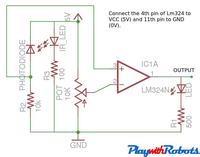zawminoo
Advanced Member level 4
Hi everybody...
I would like to make line follower sensor with photo diodes.
As following figure..
**broken link removed**
They use two diodes.
But I have only a photo diode and 3 pins IR led.


How can I do? Please help me.
I would like to make line follower sensor with photo diodes.
As following figure..
**broken link removed**
They use two diodes.
But I have only a photo diode and 3 pins IR led.


How can I do? Please help me.
